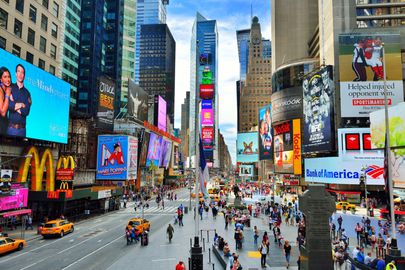

"The Center of the Universe," "The Crossroads of the World," "The Great White Way." These are just some of the nicknames that people have created for the brightest, loudest, most frenetic and most colorful area of Manhattan - Times Square. Bordered by 42nd Street in the south, 47th Street in the north, Seventh Avenue on the west and Broadway on the east, this is one of the two or three busiest pedestrian crossroads in the world. It attracts nearly forty million tourists a year and on any given day almost 330 thousand people pass under its neon displays, either going to work or just goggling around. It is the biggest tourist magnet in the world, after Las Vegas.
When Manhattan was undergoing intensive urbanization projects in the second half of the 19th century, the place that today is called Time's Square was called Longacre Square, after Long Acre Street in London. It was the center of New York's carriage industry, as Long Acre Street was in London. Cornelius Vanderbilt's son William Henry managed the American Horse Exchange there until the beginning of the 20th century. As lower Manhattan was becoming more and more exclusive, all the less reputable entertainment establishments had to move to Midtown. By the time the square's first theater, the gigantic Hammerstein's Olympia, opened on Broadway between 44th and 45th Streets in 1895, Longacre Square was being called the "Thieves' Lair." And with the advent of electricity, the square became the most attractive, the most dazzling thing in town, more sensational than any individual show.
In 1904 a major 25-story, 395-foot skyscraper was erected on Broadway and 42nd Street. It was designed by New York architect Cyrus Lazelle Warner Eidlitz and the client was The New York Times Newspaper. It became known as the New York Times Building and the square in front of it, after a subway stop was constructed underground, was renamed Times Square. Nine years later New York's most prestigious newspaper moved to a different edifice, but the New York Times Building, at the original address One Times Square, did not change its name.
Today the building itself can hardly be seen, though, since about ninety-five percent of it is covered with electronic, neon and traditional billboards. There is only one permanent tenant, the Walgreens Pharmacy on the ground floor. However, the building's owner, Lehman Brothers, still makes a handsome profit from selling outdoor advertising space. In fact, the New York Times Building is considered one of the most sought-after advertising spots in the world, with prices as high as the city's skyscrapers.
Ever since 1908 millions of spectators have gathered around Times Square each year on December 31st to watch the Times Square Ball roll down the New York Times Building. The tradition was started by New York Times owner Adolph Ochs, who had replaced the initial New Year's Eve fireworks display set off from the roof. He was the one who had saved the New York Times from ruin, bought the building and transformed the newspaper into the city's leading information source.
One of the most famous celebrations to have taken place on Times Square, and there have been a countless amount, including parades for athletes, politicians and big-name entertainers, was the Victory Day Celebration marking the end of World War 2-nd. As soon as US President Harry Truman announced America's victory over Japan on September 2, 1945, a sea of revelers flooded the square cheering the armed forces. The celebration was immortalized in one of the most acclaimed photographs of the 20th century, V-J Day in Times Square. It was taken, paradoxically, by German-born photographer Alfred Eisenstaedt, who was working for Life Magazine. The photo shows an American sailor spontaneously grabbing and kissing a white-clad nurse. It was taken right in front of the New York Times Building with the north side of the square in the background.
In the 70s and 80s most of Times Square, just like 42nd Street, had fallen into a state of moral decay. The important Broadway theaters continued functioning as normal, but the general atmosphere was not of the healthiest nature. Thanks to mayor Rudolph Giuliani, the square was thoroughly scrubbed and revitalized in the 90s, which made many aesthetic observers comment that it had lost it authenticity and flavor.
In 2009 Mayor Michael Bloomberg closed Broadway between 42nd and 47th Street to traffic, creating a broad pedestrian area to be used for outdoor seating, picnicking, entertainment, competitions or just strolling around. In 2011, with New York's severe rules against smoking, even outside, Times Square became a smoke-free area. Fines for smoking in the square start at fifty dollars.
Among the most famous landmarks embellishing the square are the wavy, electro-kinetic Coca-Cola Sign, which replaced the original bottle sign; the Hard Rock Café on Broadway; the flagship Toys R Us store, a children's paradise; the M&M's retail store, which venerates candy; and Times Square Studios, home of ABC's Good Morning America.
The little triangular square between 46th and 47th Streets is called Duffy Square. It honors Francis Patrick Duffy, a soldier, Roman Catholic Priest and military chaplain of Irish descent. He participated in the Spanish-American War and then in the heaviest fighting of World War 1st, recovering wounded soldiers during battle, on many occasions even sacrificing his life. Most of the soldiers in his regiment were Irish-Americans. After the war he became pastor at the Holy Cross Church on 42nd Street between Eighth and Ninth Avenues. Father Duffy was the most highly decorated cleric in the US Army's history. The bronze monument of the chaplain standing next to a Celtic cross in front of TKTS booth, which sells tickets for Broadway productions, was sculpted by Charles Keck and unveiled in May 1938 by Mayor Fiorello La Guardia.